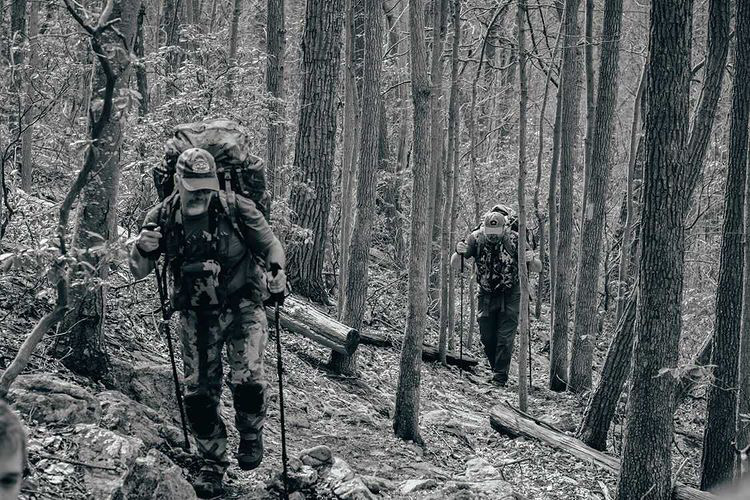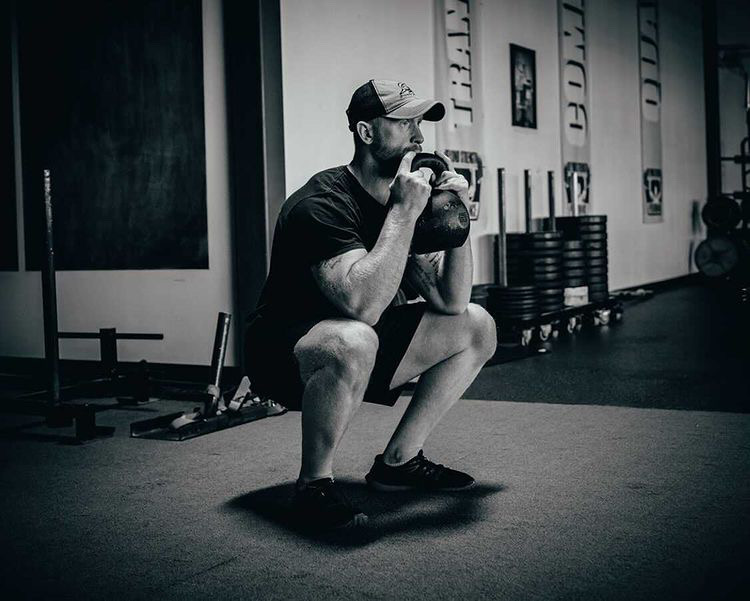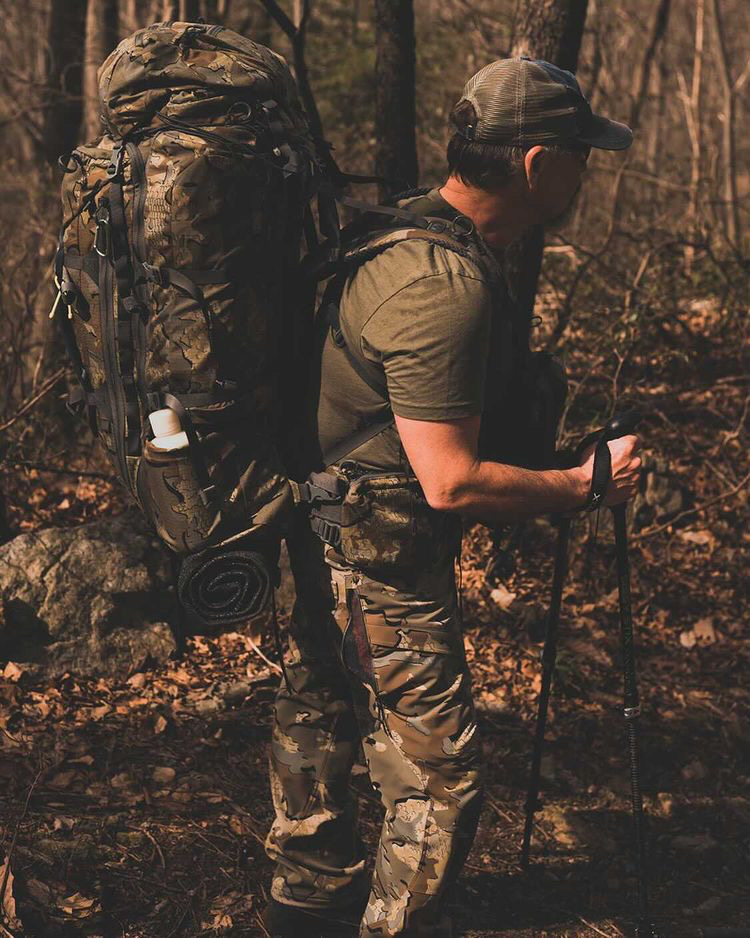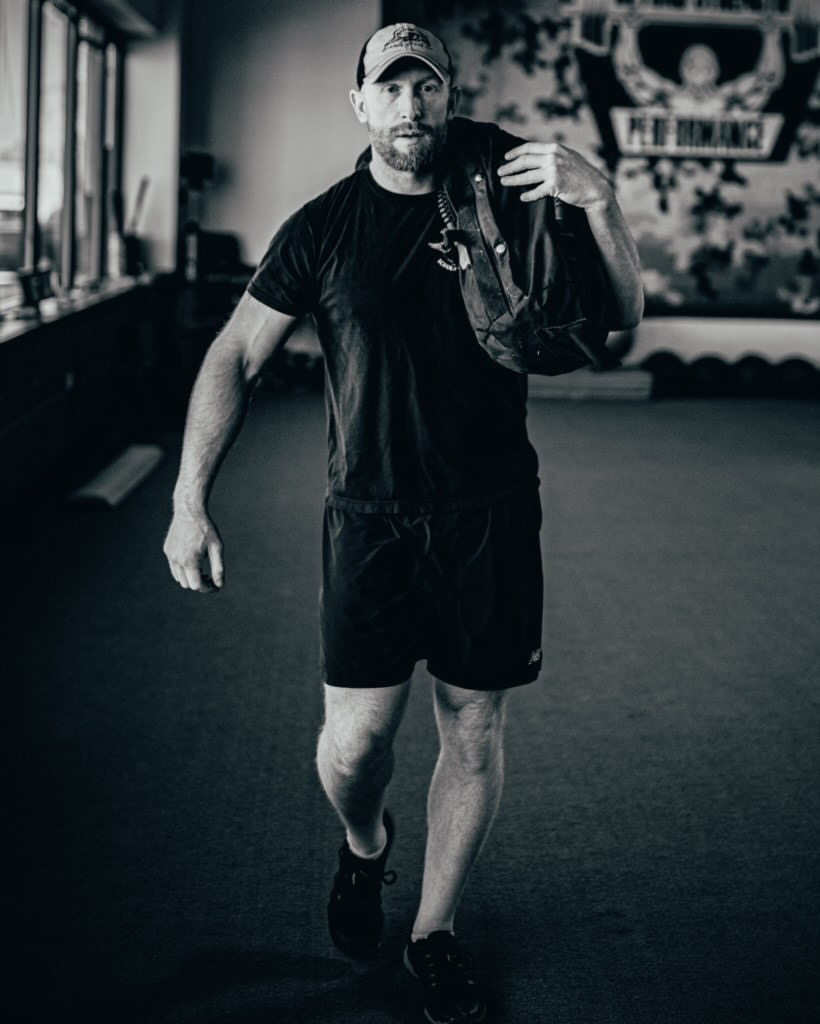Photography: John McComas
Picture this:
You’ve been diligent with your training all year long, showing up at the gym four to six days per week. You’ve even made sure you got in six to ten miles of hiking every week. It’s hunt time, and you show up feeling prepared.
But three-quarters of the way through day one, you bonk. After some miles up and down the mountain, your focus dissolves, and your legs feel heavy. Rather than sharpening your game eye, you’re focused on how tired you feel—and how surprised you are about feeling tired. Day two starts with some deep soreness, followed by a day full of physically getting your hind parts kicked in.
What in the heck happened? You trained. It shouldn’t be like this. The problem is you made a mistake that a lot of hunters make while physically prepping for a hunt:
You didn’t train all day.
In this article, we’re going to discuss simple strategies for training all day to prep your body for the demands of hunting all day.
The Gym: It’s for Building Raw Materials
I love gyms—I happen to own one. Within the confines of modern life and how little physical work is necessary for most people, the gym is an essential tool in prepping for big game hunts. But we have to understand its place.
The gym builds the physical raw materials that lead to specific training for the backcountry. It builds strength, resiliency and improves our joint mobility — we even use it to build the foundational elements of endurance. But we have to understand that it isn’t enough. Our forty-five to ninety-minute workouts are important, but they aren’t enough to prepare you for the all-day energy expenditure of hunting.
To prep for moving all day, you need to move all day.
With the gym now in the proper place in our minds, let’s talk about a simple training progression for all-day training.
Bodyweight from Morning to Night
The progression begins with doing basic bodyweight exercises (push-ups, chin-ups, squats, lunges) all day long—soon after waking until late afternoon/early evening. Each set is done with good form and is stopped before any fatigue sets in. Each rep is fast. In my Human Predator Pack Mule (HPPM) training system, this is called volume accumulation training (borrowed from Jonathan Pope and Craig Weller).
Volume accumulation does a few important things for us. It gets us moving all day long and teaches our bodies the basics of all-day energy expenditure. It builds the machinery of muscular endurance. And it teaches us to be purposeful with our movements, generating force and power with good bodily position even while we’re getting tired.
You’ll start by doing 100 reps of an upper-body movement and 100 reps of a lower-body movement throughout the course of a day. That might not sound like a lot of work, but when you’re not used to doing purposeful movement all day long, it’s taxing. You’ll do it once or twice per week, it typically falls on the same day as cardiac output training—low and slow cardio done between heart rate ranges of 110 and 140 beats per minute. If you’re a nine-to-fiver, you might have to save this training for the weekend. For the first month, stick with 100 reps.
After the first month, increase the reps—progressing up to 200 to 300 reps of each movement throughout the course of your all-day training. Once you’re hitting 200 to 300 reps and feeling good at the end of the day, it’s time to up the ante.
Miles on top of Movement
As you’re building volume with bodyweight exercises, you also need to be accruing miles on the trail. One of the biggest mistakes that hunters make is waiting too late into the year to start hiking—and then rushing to add weight to their hikes because they feel short on time. As I write these words, it’s mid-March. My HPPM clients have been hiking—unweighted—since January. It’s not too late to get started, but you need to get started as soon as possible.
Start with short hikes of an hour to one and a half hours over varied, but not soul-crushing, terrain. Continue to add time, or miles, each month. For example, I started the year doing about three to four-mile hikes (about one hour). Currently, I’m hiking six to ten miles every Sunday with very light loads if the terrain isn’t demanding (ten percent of my total body weight). I hang around a four-mile-per-hour pace, making each hike anywhere from one and a half to two and a half hours.
As the spring progresses, and after I kill my turkeys for the year, I’ll increase the hiking time leading up to two backpacking trips that I’ll take throughout the spring and summer. Each trip will be two days of all-day walking. A great strategy is to use your pre-season scouting trips for these forty-eight-hour walking extravaganzas.
The bodyweight exercises teach our body to expend energy all day. The mile accrual makes the all-day work specific. The combination prepares us for the all-day demands of hunting.
Adding Intensity
Once you’re doing 200-300 reps of the bodyweight movements, and accruing hours’ worth of miles every week, will doing more be beneficial?
From the standpoint of the bodyweight movements, likely not. It’s best to back that training volume back down for a while to avoid overuse injuries. After a refractory period, you can start building up that volume again.
Another great strategy is to add a little intensity to your all-day training to make good use of that volume that you accrued. In the strength and conditioning world, intensity means more weight.
If you have a home gym or even just some kettlebells or dumbbells at home, this strategy could work for you. You’ll apply the same technique as during the bodyweight movements, only this time you’ll use weight—and you won’t do as many reps throughout the day.
For example, you might do a goblet squat with a kettlebell for three, snappy reps, and accrue volume from morning to evening. (The weight should be relatively light—around twenty to thirty percent of your body weight depending on how strong you are.) When it comes to the weighted all-day movements, however, we aren’t going to set a goal number of reps to hit. Just do sets throughout the day, making sure that you’re doing each set with snap and good form. If you start to get fatigued to the point that your reps aren’t snappy and your body feels overly heavy, stop. Pushing too hard is going to lead to diminishing returns. We’re just teaching the body to move with a little more intensity over the course of a day. This training shouldn’t put us into the proverbial trash can.
As for the miles, a few months out from your hunt you’ll want to start rucking instead of just hiking. But the majority of your miles will be done with light loads—and if you’re going for miles, most of your miles will be done with no more than twenty percent of your body weight in your pack. You only get one spine, one set of hips, and one set of knees. Destroying them with too much heavy rucking is not a good idea.
To get used to really heavy packs, we do HICT training and short, quarter-mile intervals with heavier loads on our back. This type of planning allows you to acclimate to the weight without putting unnecessary stress on your joints.
A Note for Manual Laborers
If you’re a lady or gent that does manual labor for a living, you probably don’t need this all-day training. I say probably because there are always extenuating circumstances. But folks that move all day for a living already have bodies that are prepared to do so.
That being said, if this is an easier way for you to get your training in because you don’t have huge blocks of time to get to the gym throughout the week, go ahead and get after it.
Closing Thoughts
If you want to be able to hunt all day with stamina and focus, you have to prep your body to do it. Accrue your all-day training volume while you accrue miles on the trail and you’ll be far better prepared for your hunts this fall.





